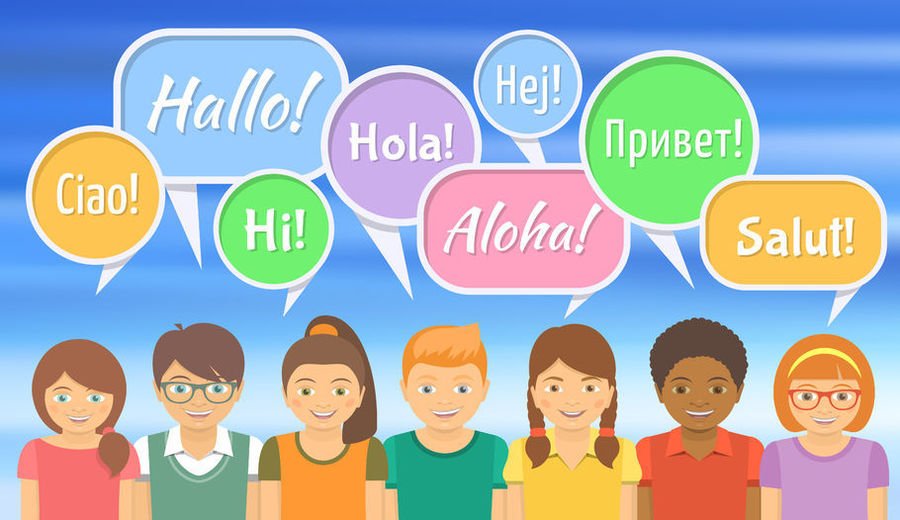IMPORTANCE OF LEARNING FOREIGN LANGUAGE FOR KIDS
Language is the medium through which people communicate.It is the way of expressing something with abstract system of symbol and meanings. The importance of language is essential to every aspect and interaction in our everyday lives. We use language to inform the people around us of how we feel, what we desire, and question/understand the world around us.
Language plays a very important role in the development of a person personality, it helps in the development of a person’s cognitive skills and social development of person.
Language consists of four dimensions: the sound system (i.e., the phonology), the meanings system (the semantics), the world formation rules (the morphology), and the sentence formation rules (the syntax). The different subsystems involved in the acquisition of a language are assumed to have differences in developmental progression and the optimal period for acquiring them.
WHY LEARNING A FOREIGN LANGUAGE IS BENEFICIAL IN THE EARLY AGE
Children are sponges, and can learn much more at an earlier age.
Mastering a second language, and the learning skills for it, are best acquired and transitioned into by age 7, however, in some children, the window of language opportunity can remain open until the end of puberty.According to the research, the earlier a child was exposed to a second language, the better the child did.
Preschool years, especially the first three years of life, are believed to be a vital period in a child’s life. This is when the foundations for attitudes, thinking, and learning, among others, are laid down.This means that children have a natural ability to learn, which is developed during the first 3-4 years of their life.
For a child, learning language is part of their brain chemistry. They are literally built to absorb information; they do this in an unconscious state of mind, like they’re learning and they don’t even know it.
Science indicates that babies’ brains are the best learning machines ever created, and that infant’s learning is time-sensitive. Their brains will never be better at learning a second language than they are between 0 and 3 years of age.
Although some findings have indicated that young child up to the age of 5 can process up to five languages.
Language learning depends on the processing of sounds. All the world’s languages put together comprise about 800 or so sounds. Each language uses only about 40 language sounds, or “phonemes,” which distinguish one language from another.
Research shows babies begin to learn language sounds before they’re even born. In the womb, a mother’s voice is one of the most prominent sounds an unborn baby hears. By the time they’re born, newborns can not only tell the difference between their mother’s language and another language, but also show a capability of distinguishing between languages.
Children may not be better at learning languages in terms of inputting effort and dedicating time towards this aim, but they are certainly better than adults at acquiring the correct grammatical and phonetic structure of a foreign language. Age-associated changes in brain structure and plasticity make the task of learning a foreign language more difficult for older people as their brains process information differently.
CHARACTERISTICS OF A BILINGUAL OR MULTILINGUAL KIDS
. Many researchers have studied the brain of bilingual children and the impact of bilingualism and multilingualism in promoting cognitive development. It has been found that the brain of bilingual and multilingual children works differently than the brain of monolingual children, and these differences provide several advantages to children that speak more than one language.
. These kids grow up well through their youth, adolescence, adulthood, and into old age.
.One of the main benefits of learning a second language at an early age is that children learn languages faster and easier, they have more time to learn, less to learn, fewer inhibitions, and a brain designed for language learning.
.Studies by Harvard University confirm that the creativity, critical thinking skills, and flexibility of the mind are significantly enhanced if children learn a second language at a younger age.
.Studies have shown that the younger the learner, the more they can adopt pronunciations and recreate new sounds. And, children around the age of three or four can learn through play because their minds aren’t yet overwhelmed by facts and information that needs to be stored and assessed, which is something that happens as we grow older.
. A study conducted by a director of the cognitive neuroscience laboratory for language and child development, has demonstrated that after the teen years, the brain changes and makes it extremely challenging for an adult to learn a foreign language. This doesn’t mean that they can’t learn it however, they won’t do so the same way as a child because the mechanisms that help language learning are not the same as they are at ages 2-5.
.Multiple language speakers seem to undergo plastic changes in certain brain networks enabling them to handle control of multiple languages.
.It is common for children that are learning two languages to mix words from one language to the other. This is call “code-switching” or “code-mixing” and you should not get worried because of it because it’s a fact that code-switching is a highly appreciated and skilled form of language use in the academic community.
.Once the child is of four these bilingual children are more aware of which language to use in the community and public places. You can also expect them to have developed sufficient vocabulary in both their mother tongue and second language by that time.
.Research has found that bilingual children show an improved executive functioning of the brain, that is, they are able to shift attention, switch between tasks and solve problems more easily. They have also been found to have increased metalinguistic skills. There is evidence that being bilingual makes the learning of a third language easier.
ADVANTAGES OF LEARNING A FOREIGN LANGUAGE
Here are some advantages of learning a second or foreign language:
1. BOOSTS BRAIN POWER
Some of the cognitive advantages of learning a second language is the fact that the brain of bilingual and multilingual children develops more densely.
2. BETTER PROBLEM-SOLVING AND OTHER COGNITIVE ABILITIES
Children who learn a second language grow up to be expert problem-solvers and creative thinkers. Their brains experience a constant workout from a young age as they try to sort out which language to speak and when. Researchers have found that in addition to enhanced problem-solving skills, bilingual children are better at planning, concentrating, and multi-tasking.
3. CHILDREN DEVELOP AN “EAR” FOR LANGUAGES
Exposing children to a foreign or second language at an early age helps them develop an “ear” for the language and achieve better pronunciation and fluency later in life. According to some studies, children who learn a second or foreign language before teenage years are more likely to achieve native-like pronunciation.
4. HIGHER ACADEMIC ACHIEVEMENT AND TEST SCORES
Studies have shown that learning a foreign language early in life improves cognitive abilities and influences achievement in other areas, resulting in higher test scores in reading and math.
5. GIVES STUDENTS A HEAD START
children that learn a language at an early age have a huge head start both cognitively and linguistically, and it will help them “breeze” through foreign language classes in high school and college, giving them a chance of truly becoming bilingual.
6. INCREASED EMPATHY
A study from the University of Chicago found that children that speak more than one language are better at “putting themselves in other people’s shoes” and understanding different perspectives.
7. INCREASED CHILDREN’S UNDERSTANDING OF HIS OR HER NATIVE LANGUAGE
Learning another language helps students learn about how language works in general and become more aware of their own first language (grammar, conjugations, sentence structures, etc.) Studies have found that bilingual children understand better than monolingual students the visual representation of print materials.
8. BETTER UNDERSTANDING OF OTHER CULTURES AND CONNECTING WITH PEOPLE THAT SPEAK OTHER LANGUAGES
Bilingualism allows for cross-cultural communication. Children who speak more than one language have the opportunity to become more culturally aware and have the ability to better understand and appreciate cultural differences, which helps them be more open to different ways of thinking and allows them to experience the world with “new eyes”.
9. BETTER CAREER OPPORTUNITIES
In today’s global world, the ability to communicate in more than one language is increasingly becoming an essential skill. When applying for a job, bilingual candidates have an edge over other candidates, and are able to showcase themselves as a valuable potential employees bringing skills that may be invaluable for employers.
Whether these children grow up to become translators or interpreters in a specific field or find a job in the field while marketing themselves as bilingual, their salaries will be much greater than the salaries of their monolingual coworkers.
10.LEARNING A SECOND LANGUAGE PREVENTS FUTURE AGE-RELATED ILLNESSES
Many studies have hypothesized that people who speak a second language regularly may be able to delay Alzheimer’s disease by 4.5 years.
New research published in the journal Neuropsychoelogia, reveals that bilingualism makes changes in brain structure that are linked with resilience against Alzheimer’s disease and mild cognitive impairment.
Researchers have found that actively using two languages seems to have a protective effect against age-related dementia.
Researchers reason that this is due to the constant workout that a bilingual brain experiences as they constantly filter through information in two languages.
In our increasingly diverse society, people from different countries and cultures must develop tools to communicate effectively with each other. A world in which different cultures and languages are valued and appreciated, with open, aware and empathetic people, is a better world for our children.








